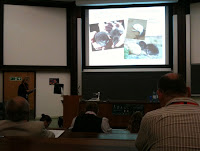I somehow managed to squish everything back into my
suitcase, and left it at the accommodation to collect later. I think this was the
first day I made it to the first session of the morning, but Richard Sherley
and Katrin Ludynia, my supervisors on the Earthwatch expedition on Robben
Island, were presenting so that was double incentive not to be late.
 There were a range of talks today, some about foraging and
prey ability, whilst others explored new technologies available.
There were a range of talks today, some about foraging and
prey ability, whilst others explored new technologies available.
Katta’s presentation was about the penguins on Dyer Island,
which faces some severe challenges and may not exist in 5-10 years’ time.
Although clutch size is 1.8 eggs per pair, only 0.5-0.8 are surviving to
fledging. Of these, only 25% survive
beyond their first year. Many penguins are migrating away. As the island is
more to the East, food availability is not a major factor. 7-8% are lost to
seal predation; 4% to incidental oiling. This year, 95 chicks died from
hypothermia following a major storm. A large culprit is avian predators, with 30
eggs per day taken by a large population of kelp gulls. Models have been developed to show the impact
of each of these factors.
The first really techie talk of the day was a study of egg
incubation time in Adelie penguins in the Antarctic. This involved substituting a real egg with a
dummy one (viable only in non-endangered species!), which collected a range of
environmental data including temperature and when the egg was turned by its
parent. Interestingly temperature and wind made little difference to the egg,
but snow did increase the stress level of the adult, lower the temperature and thus increase the incubation
time. So ultimately if climate change causes more precipitation, breeding could
take longer, eventually leading to a population decline.
A big brother moment came before lunch with Lynch’s talk.
This included satellite imagery at 60cm resolution, which allowed the mapping
of areas that are inaccessible. As Adelie’s have a certain nest behaviour
leading to a set density, numbers of birds could be worked out from guano covered
areas. One colony was mapped and measured in 4 hours from the office, as
opposed to a 4 week expedition costing £k. What is scary is that the data is
available at 10cm resolution or finer – which would allow identification of
individual penguins – but it is not widely available for security reasons.
Another amazing talk by Hart was about camera images. These
can be set up in remote parts of the Antarctic, and set up to relay pictures
back to base, with batteries lasting up to a year if images are shot in time
lapse rather than video stream. It records background information as well, ie.
abiotic environmental data like extent of sea ice cover, weather, etc. Or,
cameras can focus on individual nests to record behaviour at a finer level. It
is a non-invasive way of monitoring populations, and audio capture is being
explored. This can identify chicks, and their age from the type of call. The
technology is constantly being improved, and they are looking at a citizen
science project called Zooniverse to help process the film captured and count
penguins. Awesome to think I could take part in a penguin census in the
Antarctic without leaving the house! The last presentation I am going to mention was another
technology one, by Handley. In the same way that data loggers and depth
recorders are attached to penguins to capture foraging data, he applied video
cameras to birds to record a visual of their foraging trips. Results are still
being worked through but this helps by showing actual behaviour as it happens,
the environment the penguins is working in, species captured and eaten (without
the need for stomach flushing or blood isotope tests), and interactions with
other penguins.
The last presentation I am going to mention was another
technology one, by Handley. In the same way that data loggers and depth
recorders are attached to penguins to capture foraging data, he applied video
cameras to birds to record a visual of their foraging trips. Results are still
being worked through but this helps by showing actual behaviour as it happens,
the environment the penguins is working in, species captured and eaten (without
the need for stomach flushing or blood isotope tests), and interactions with
other penguins.
I’ve learnt lots this week about scientific method and
process as well as penguin facts, so all in all an excellent week. And one more Gromit bagged at Templemeads station on the way
to catch my train home :)
No comments:
Post a Comment